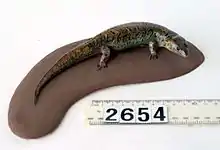Robust skink
The robust skink, Oligosoma alani (formerly Cyclodina alani),[1] is a large, rare species of skink endemic to New Zealand.[2] This species was once widespread throughout the North Island[3][4] but has been wiped out in most parts of its former range by predation from several species of introduced rats - it now occurs naturally only on 6 small islands off the north-eastern coast of the North Island.[3]
| Robust skink | |
|---|---|
 | |
| Scientific classification | |
| Kingdom: | Animalia |
| Phylum: | Chordata |
| Class: | Reptilia |
| Order: | Squamata |
| Family: | Scincidae |
| Genus: | Oligosoma |
| Species: | O. alani |
| Binomial name | |
| Oligosoma alani | |
| Synonyms | |
|
Cyclodina alani | |
The specific epithet for this animal was given by the describer Joan Robb in honour of her nephew, Alan Robb.[4]
Robust skinks are strongly nocturnal and live under rocks, or in seabird burrows, tree stumps and fallen logs. They prefer well vegetated areas with plenty of leaf litter and tolerate coastal areas as long as there is dense vegetation cover.[5] Studies of robust skinks show they are unusually vulnerable to losing water through their skin, which may explain their preference for damp environments such as crevices, bird burrows, rotting logs and closely matted vegetation.[6]
References
| Wikimedia Commons has media related to Oligosoma alani. |
| Wikispecies has information related to Oligosoma alani. |
- Chapple, David G.; Ritchie, Peter A.; Daugherty, Charles H. (August 2009). "Origin, diversification, and systematics of the New Zealand skink fauna (Reptilia: Scincidae)". Molecular Phylogenetics and Evolution. 52 (2): 470–487. doi:10.1016/j.ympev.2009.03.021. PMID 19345273.
- Australasian Reptile & Amphibian Specialist Group (1996). "Oligosoma alani". IUCN Red List of Threatened Species. 1996. doi:10.2305/IUCN.UK.1996.RLTS.T6010A12299648.en.
- Morris, R; Ballance, A. (2008). Rare Wildlife of New Zealand. Wellington, New Zealand: Random House. p. 224. ISBN 978-1-86941-912-7.
- Brian Gill and Tony Whitaker,"New Zealand Frogs and Reptiles", David Bateman, 2001
- Downs, D. R. (August 1999), Cyclodina spp. skink recovery plan 1999-2004 (TSRP-27). Threatened Species Recovery Plan Series, No. 27 (PDF), Wellington, New Zealand: Department of Conservation (Te Papa Atawhai), p. 69, ISBN 0478218389, ISSN 1173-2946
- Cree, A., Daugherty, C. H., Towns, D. R. Unpublished research. Cited in DOC TSRP-27.
